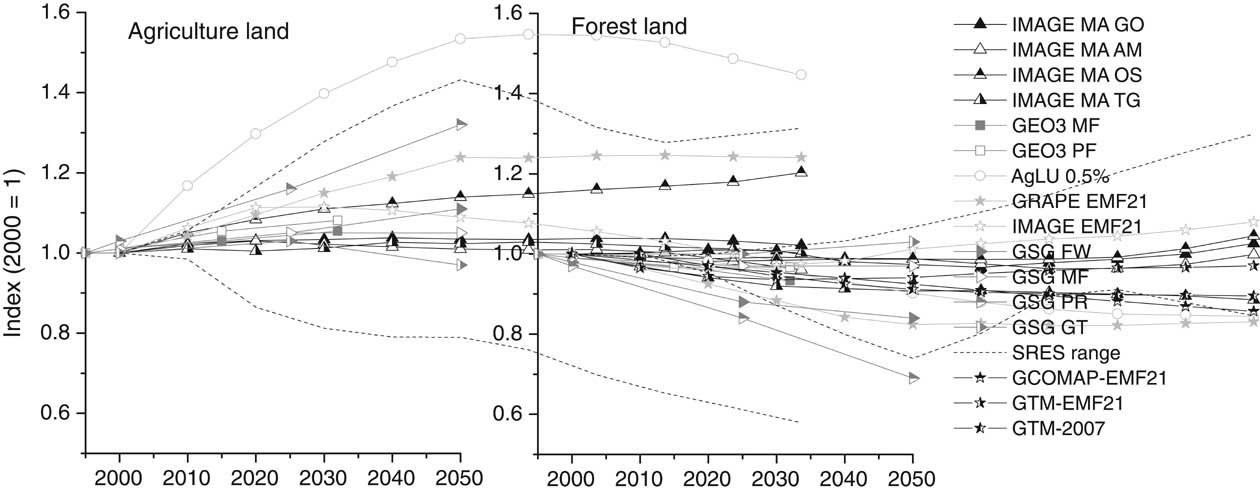
| Previous | Return to table of contents | Search Reports | Next |
| « Back to weltagrarbericht.de | ||
Outlook on Agricultural Changes and Its Drivers | 283

Figure 4-20. Projected landuse changes for (a) agricultural land and (b) forest land from selected scenarios (indexed to year 2000)
Notes: Agricultural land is an aggregate of cropland and grazing/pasture/grassland land types. The following scenarios were redrawn from Alcamo et al., 2006: GSG xx = Global Scenarios Group (Raskin et al., 2002) scenarios from the PoleStar model (MF = Market Forces, PR = Policy Reform, FW = Fortress World, GT = Great Transition); GEO-3 xx = Global Environment Outlook 3 (UNEP, 2004) scenarios using the PoleStar model (MF = Market First, PF = Policy First). The other scenarios were assembled from various sources: SRES (Special Report on Emissions Scenarios) = IPCC, 2000; IMAGE-EMF21 = van Vuuren et al., 2006 scenario from EMF-21 Study; IMAGE-MA-xx = MA, 2005 scenarios from the IMAGE model for four storylines (GO = Global Orchestration, OS = Order from Strength, AM = Adapting Mosaic, TG = TechnoGarden); AgLU-0.5% = Sands and Leimbach, 2003 scenarios with 0.5% annual growth in crop yield; GTM-EMF21 = Sohngen and Sedjo, 2006 global forest scenario from EMF-21 Study; GCOMAP-EMF21 = Sathaye et al., 2006 global forest scenario from EMF-21 Study; GTM-2007 = Sohngen and Mendelsohn, 2007 global forest scenario; GRAPE-EMF21 = Kurosawa, 2006 scenario from EMF-21 Study.
rect drivers act in addition to global (indirect) drivers. For example, in cultivated systems, cultural, socioeconomic, and educational background as well as expectations, perceptions, preferences, and attitudes toward risk of farmers and farm households can play significant roles in shaping land use choices. Tropical deforestation depicts the connectedness of multiple drivers. In the humid tropics, deforestation is primarily the result of a combination of commercial wood extraction, permanent cultivation, livestock development, and the extension of overland transport infrastructure (e.g., Strengers et al., 2004; Verbist et al., 2005; Busch, 2006; Rounsevell et al., 2006). However, regional variations exist. Deforestation driven by swidden agriculture (see 4.5.1.2) is more widespread in upland and foothill zones of Southeast Asia than in other regions. Road construction by the state followed by colonizing migrant settlers, who in turn practice slash-and-burn agriculture, is most frequent in lowland areas of Latin America, particularly in the Amazon Basin. Pasture creation for cattle ranching is causing deforestation almost exclusively in the humid lowland regions of mainland South America. Expansion of small-scale agriculture and fuelwood extraction for domestic uses are important causes of deforestation in Africa (Geist and Lambin, 2002; FAO, 2006b) and Latin America (Echeverria et al., 2006). Recently, two new land use types that are partly related to new drivers have emerged: bioenergy production (see 4.4.5.4) and soybean expansion driven by international markets, but also by the development of GMOs has rapidly become a major threat in Latin America (see Box 4-3). |
|
The range of combinations of factors is not infinite, although single-factor causes are rare (Reid et al., 2006). A significant share of land use changes involves lifestyle choices and shifting consumption patterns; governance; global markets and policies. Underlying causes often have a strong influence on local land use and cover changes. In the same way, land use alters in multiple ways agricultural production and AKST. |
| Previous | Return to table of contents | Search Reports | Next |
| « Back to weltagrarbericht.de | ||